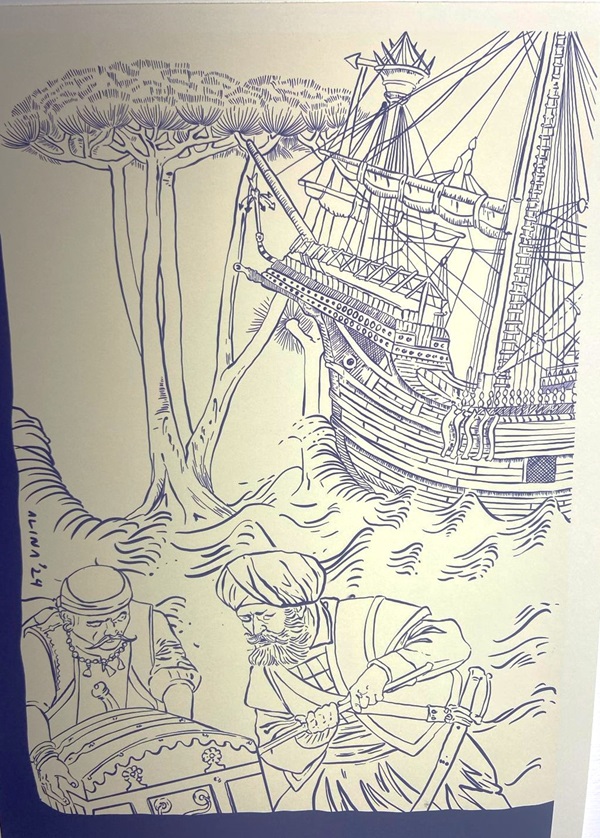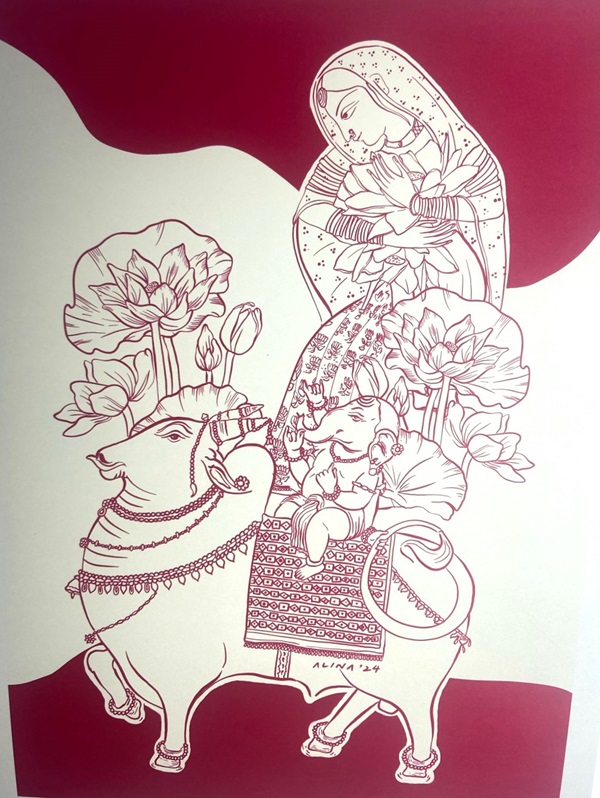Written by: Haroon Shuaib
Posted on: March 13, 2024 |  | 中文
| 中文
Ajrak, the earliest symbol of the Indus Valley Civilization, which can also be found on the couch of the Egyptian Pharoah
In June 2023, Line Green Visual Art Space, tucked away neatly in the I-8 sector of Islamabad, hosted a collaborative exhibition titled Hamara Watan: Punjab ki Chund Kahaniyan (Our Homeland: A Few Stories from the Punjab), with a promise that the gallery will continue this series to cover other regions of Pakistan. On the 8th and 9th March, 2024, second chapter of the series was exhibited by the gallery, focusing on the mystical land of Sindh. It had the title, Hamara Watan: Sindh Ki Chund Kahaniyan (Our Land: A Few Stories from Sindh). The exhibition, like its precursor, was also a collaborative presentation of Line Green Visual Art Space, Purana Pakistan, and Travel Names. An innovative curative experience of story-telling, live musical performance, illustrations and geo-mapping, the exhibition explored the enigma that is Sindh and featured 14 tales from its rich, cultural and spiritual legacy that transcends both time and borders.
For Alina Akbar, founder and creative director of Line Green, qualified visual artist and curator of the exhibition, it is a passion project that offers a natural convergence point. While the tales were jotted down by Laraib Asdaf and of Purana Pakistan, Alina used her creative prowess to develop digital illustrations for each story. Mahad Nayyar from Travel Names geo-tagged each story, so that attendees could scan a QR code displayed and virtually visit the exact geographical location where it had taken place. Schanze also held a story narration session each day of the exhibition. Her talk was complemented with a mesmerizing live performance of internationally acclaimed flutist, Mr. Salman Adil, who had worked with legendry singers such as Abida Parveen, Ghulam Ali, Reshma and Mehdi Hassan. Salman Adil played spellbinding flute tunes, tracing their roots to the magical land of Sindh. Creativity, music and poetry have been a way of life for centuries in Sindh, and provided the perfect backdrop for Schanze’s fascinating narration.
Sindh is a land accepted as one of the six cradles of civilization. The other civilizations regarded as great are Mesopotamia, Ancient Egypt, Ancient China, Caral-Supe civilization of coastal Peru, and the Olmec civilization of Mexico. Alina and Purana Pakistan begin the story of Sindh with presenting a visual and narrative homage to the antiquity of Sindh, and featuring the story of the ancient art of weaving cotton fabric and natural dying through stamping in the form of ‘Ajrak’, traces of which can be found in the Mohenjo-Daro ruins. Considered to be a symbol of the sophistication and advancement that the civilization had attained during its time, the bust of the priest king found at the site, dating back to 2500 BC, also has a similar cloth draped around his shoulders. Purana Pakistan draws attention to the fact that while Ajrak is a cloth that is universally and indiscriminately enjoyed by every level of the society in Sindh even today. There is evidence that it was also a very popular export of the Indus Valley. Archeologists have found fabrics with similar patterns on various objects in excavations around the world, as far away as Mesopotamia and Egypt. This link forms the basis for the illustration in crimson that Alina creates, where the King Priest of Mohenjo-Daro and the Tutankhamun are depicted side-by-side, with the same familiar trefoil motifs and the majestic zebu bulls used in carts. All these motifs and symbols indicate that the Indus Civilization was peaceful and an agrarian society.
This spirit of excellence, harmony with nature, creative and scholastic brilliance and deep spiritualism that has remained a hallmark of Sindh, is perfectly captured in the other 13 stories and their corresponding digital art pieces as well. The story of Bawarij, ancient boat people, some of whom formed the fiercest pirates in history, is indicative of the maritime knowledge that the people of this land possessed. The continuity of architectural brilliance practiced over centuries by the people of this land is depicted through stories about Makli, one of the largest Necropolis in the world, with its concentration of almost a million beautifully embellished graves within a radius of 10 kilometers. Ranikot Fort that is also called ‘The Great Wall of Sindh’, because of its 30-kilometer-long circumference, and the city of Hyderabad, known for its fascinating ventilating structures or ‘Wind-Catchers’ developed during the 17th century’s Kalhoro dynasty. To pay homage to the spiritual traditions of the land, Shah Abdul Latif Bhittai, the Sufi mystic from the ancient town of Hala, who is also known as the ‘Shakespeare of Sindh’, as his stories are full of romance, devotion and divine love, captured through the accounts of ‘the Seven Queens of Sindh’. The story of Pir Mangho of the 13th century, who is considered a patron saint by many, but particularly by the Sheedi community (descendants of the African-Arab people of Zanzibar) of Sindh, are the subject of three illustrations and accompanying stories.

Bawarij were Sindhi pirates, named for their distinctive barja warships, which means large vessels of war in Arabic
The story of Pir Mangho is fascinating, and intrigues one to learn more about the miraculous traditions attached with the shrine that is revered by people of all ethnicities and religions. The pond attached to it has over a hundred crocodiles. This saint’s story is revealing of the inclusive and harmonious nature of Sindhi society, which is further reinforced by the artists and historians through stories of Mithi, a village in Tharparkar desert of Sindh, where Hindus fast during Ramadan and Muslims don’t slaughter cows, as it is considered sacrilegious by its sizable Hindu population. The story of Dadi Leela, a Hindu musician, artist, teacher, public representative and reformist, whose entire family migrated to India after 1947. However, she chose to stay on in Sindh and worked tirelessly for the betterment of Sindhi society, till she finally passed away in 2017 at the age of 101.

The pluralistic spirit of Mithi has been depicted by Alina through the image of a Muslim woman with her head covered and sacred symbols of Hinduism
Stories of the Khudabadi script of the Sindhi language is considered one of the most ancient languages of the Indian sub-continent. The erstwhile capital of the Arab empire in Sindh, Mansura, was from where ancient knowledge was exported to the Arabian Peninsula, and translated from Sanskrit to Arabic, enriching the fields of trigonometry, mathematics and astronomy. The perfect celestial globe made by a Sindhi metallurgist, Mohammad Saleh Thattvi, during the Mughal period, and the story of Elsa Kazi, a German poet, writer, historian, painter, composer and musician whose contributions enriched the social and cultural tapestry of modern-day Sindh, her adopted home till she died, indicate the intellectual wealth that the land of Sindh possessed.
According to Alina, “For this chapter, we have curated a collection of stories concentrated with Sindh’s culture and heritage, that showcase the creativity, timelessness, diversity, intellect and love of the Sindhi essence. With insightful illustrations, live story-telling and musical performances and engaging conversations, one can experience a new appreciation and deeper understanding of Sindh’s character and soul.” For Alina, the impetus of founding Line Green is the urge to create a space that houses the condensations of creative art, collaborations, research-based art-practices, conceptual exposition of diverse expressions and a lot more. Purana Pakistan describes itself as an online archive, striving to create awareness amongst Pakistanis of the richness of their social and cultural heritage and legacy, while documenting the past and the present for the future. Travel Names is an archive of locations and photographs, and aspires to eventually create a geolocation app that users can leverage to find lesser-known historical sites, and places of natural beauty and interest in Pakistan.
It would definitely be worthwhile for Alina, Purana Pakistan and Travel Names to consider compiling all their work in a beautiful coffee table book with stories, illustrations and geotags, once all the regions of Pakistan are covered through this series.
You may also like: